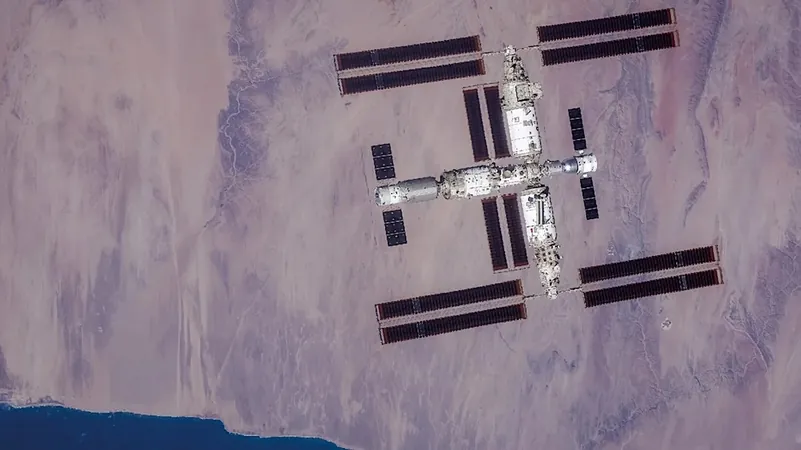
Shocking Discovery: Asteroid 2024 YR4 Reveals Its Surprising Shape and Origins!
2025-04-08
Author: Nur
Asteroid 2024 YR4: A Surprising Discovery
Asteroid 2024 YR4, which recently captured the world’s attention with fears of a potential impact with Earth, has an unexpected narrative unveiling its origins and striking characteristics. According to a groundbreaking study, this space rock likely comes from the central region of the asteroid belt, situated between Mars and Jupiter—a region not typically associated with asteroids that venture close to Earth.
Collision Risk and Observational Efforts
After its discovery late last year, astronomers calculated a 1.3% chance of 2024 YR4 colliding with Earth in December 2032, which briefly positioned it among the most-watched space objects by NASA and the European Space Agency. This alarming statistic initiated urgent planetary defense discussions and prompted swift observational efforts to refine its trajectory. Fortunately, experts anticipated the risk would diminish with improved data—and they were right. By late February, the collision threat had dwindled to nearly zero, and by early April, images captured by the James Webb Space Telescope confirmed that the asteroid would safely pass by Earth in 2032. Nonetheless, there remains a 2% chance it could strike the moon.
New Origins and Unique Characteristics
New observations from the Gemini South telescope in Chile and the Keck Observatory in Hawaii have strengthened evidence that 2024 YR4 originated from this unusual region of the asteroid belt. Its retrograde spin—meaning it rotates in the opposite direction to its solar orbit—provides crucial insights into its genesis. This unique rotation, along with the Yarkovsky effect—a force caused by uneven heating of the asteroid—suggests that over time, 2024 YR4’s path shifted inward, bringing it into a near-Earth orbit.
Dr. Bolin, a key researcher in the study, expressed surprise at the asteroid’s location of origin, stating that scientists previously didn't consider the central main asteroid belt as a likely source for Earth-crossing asteroids. Gravitational interactions, particularly with Jupiter, are thought to have nudged 2024 YR4 into its current trajectory.
Physical Characteristics of 2024 YR4
Astonishingly, this asteroid also boasts a rapid rotation period of just 20 minutes. Detailed analyses of its light curve—fluctuations in brightness—allowed researchers to determine both its composition and its distinctive flattened, hockey-puck-like shape. 'Most asteroids are typically shaped like potatoes or tops, so this find was rather unexpected,' Bolin remarked.
While many asteroids larger than 328 feet (100 meters) are referred to as 'rubble piles,' consisting of fragments loosely anchored together, 2024 YR4 falls into the size range of having significant boulders, potentially indicating it was once part of a larger rubble-pile asteroid.
Conclusion and Future Monitoring
As exploration of space continues to advance, data gathered from studies like this can significantly bolster our understanding of potentially threatening asteroids and enhance rapid response observational tactics. The fascinating revelations about 2024 YR4 demonstrate the complexities of our solar system and remind us of the importance of monitoring these celestial objects as they glide through the cosmos.
Stay tuned for the next development in the ongoing investigations of asteroids that could one day cross our path!



 Brasil (PT)
Brasil (PT)
 Canada (EN)
Canada (EN)
 Chile (ES)
Chile (ES)
 Česko (CS)
Česko (CS)
 대한민국 (KO)
대한민국 (KO)
 España (ES)
España (ES)
 France (FR)
France (FR)
 Hong Kong (EN)
Hong Kong (EN)
 Italia (IT)
Italia (IT)
 日本 (JA)
日本 (JA)
 Magyarország (HU)
Magyarország (HU)
 Norge (NO)
Norge (NO)
 Polska (PL)
Polska (PL)
 Schweiz (DE)
Schweiz (DE)
 Singapore (EN)
Singapore (EN)
 Sverige (SV)
Sverige (SV)
 Suomi (FI)
Suomi (FI)
 Türkiye (TR)
Türkiye (TR)
 الإمارات العربية المتحدة (AR)
الإمارات العربية المتحدة (AR)